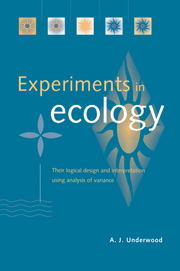Book contents
- Frontmatter
- Contents
- Acknowledgements
- 1 Introduction
- 2 A framework for investigating biological patterns and processes
- 3 Populations, frequency distributions and samples
- 4 Statistical tests of null hypotheses
- 5 Statistical tests on samples
- 6 Simple experiments comparing the means of two populations
- 7 Analysis of variance
- 8 More analysis of variance
- 9 Nested analyses of variance
- 10 Factorial experiments
- 11 Construction of any analysis from general principles
- 12 Some common and some particular experimental designs
- 13 Analyses involving relationships among variables
- 14 Conclusions: where to from here?
- References
- Author index
- Subject index
14 - Conclusions: where to from here?
Published online by Cambridge University Press: 05 June 2012
- Frontmatter
- Contents
- Acknowledgements
- 1 Introduction
- 2 A framework for investigating biological patterns and processes
- 3 Populations, frequency distributions and samples
- 4 Statistical tests of null hypotheses
- 5 Statistical tests on samples
- 6 Simple experiments comparing the means of two populations
- 7 Analysis of variance
- 8 More analysis of variance
- 9 Nested analyses of variance
- 10 Factorial experiments
- 11 Construction of any analysis from general principles
- 12 Some common and some particular experimental designs
- 13 Analyses involving relationships among variables
- 14 Conclusions: where to from here?
- References
- Author index
- Subject index
Summary
Be logical, be eco-logical
The major purpose of the information provided here is to help you to get good professional help. Use the information to help to plan and to consider the relevant parts of the biology so that your discussions with statistical advisers include the biological reasons why the requirements and assumptions of statistical procedures may be problematic. Use available accounts of experiments and reviews of experimental procedures as tools to evaluate designs – not just as methods of identifying ways of doing experiments. Use other accounts (such as the text by Scheiner & Gurevitch (1993), which appeared during the final writing of this one). Constantly probe better ways of doing experiments.
Do not be frustrated that this book has not discussed such topics as how to deal with unbalanced sets of data. Apart from the serious recommendation that we try to avoid having unbalanced data in the first place, the issues are complex and beyond this discussion. You will need help, but the help you get will be improved if you are aware of the issues.
The preceding sections were chosen to be an introduction to the major themes of modern experimental design as needed by ecologists. The issues discussed are the most general in ecological experimentation. Spatial scales of patterns and processes vary. Intensities of effects and outcomes of processes vary from place to place and time to time.
Information
- Type
- Chapter
- Information
- Experiments in EcologyTheir Logical Design and Interpretation Using Analysis of Variance, pp. 478 - 485Publisher: Cambridge University PressPrint publication year: 1996
